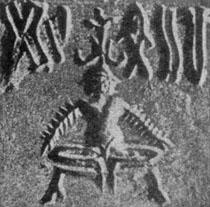 |
|
Image
of the proto-Shiva; terracotta
seal, 2000 B.C. |
Shiva is an ancient god, as old as civilization itself. Perhaps older. He was first realized the day man accepted the cosmic truism: to create, one must first destroy.
The Rig Veda, the oldest religious text known to mankind, refers to Shiva as Rudra, the wild god, one who dwelt in ominous places like crosseroads and shot arrows that spread disease. Gifts, hymns and sacrifices were offered to appease him. He was so feared that one is advised in the Aitreya Brahmana against even mentioning his name.
But these texts were written only around 1500 B.C. A thousand years earlier Shiva's image had already appeared on terracotta seals of the Indus valley civilization. There he was portrayed as Pashupati, the lord of the beasts, surrounded by his wild jungle menagerie. He was also seen as a yogi, a mystic, sitting in meditative postures.
Even before the Indus valley civilization, or any civilization for the matter, Shiva was known to tribals as the divine shaman: the tracker, the hunter, the medicine-man, a gentle yet mysterious soul who, by use of secret drugs and ritual dancing, could reach different levels of consciousness.
Shiva existed at the dawn of pre-history when society was dominated by a pantheon of female divinities. His cult fused with that of the great mother-goddess, Shakti. Union was not difficult when people realized that the two were complementary halves of the whole truth, like man and woman, the linga and the yoni.